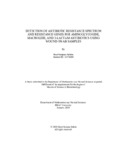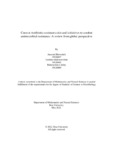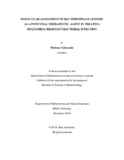| dc.description.abstract | Antibiotic resistance has become a global health problem with a decrease in efficacy in treating common infections, resulting in increased sufferings, duration of hospital stay and economic burden. Infections in the wound site by multi-drug resistant pathogens play an important role in the development of chronicity and delaying wound healing.
Unfortunately, information regarding resistance spectrum of the isolates and the associated genes, which are important for physicians in order to prescribe empirical
treatment as well as to contain the spread of infections, is still lacking in Bangladesh.
Hence, the aim of this study was to investigate antibiotic resistance in pathogenic organisms, isolated from wound sites, both phenotypically and genotypically. A total
of 217 specimens were collected from outpatients affected with wound infections who visited for dressing purpose at Bangladesh Institute of Health Sciences Hospital (BIHS) and Shaheed Suhrawardy Medical College & Hospital, from January 2017 to March
2019. Identification and confirmation of the isolates were done by appropriate microbiological and biochemical methods. Furthermore, antibiogram was performed using Kirby–Bauer disk diffusion approach. PCR was performed using ESBL, macrolide and aminoglycoside resistance gene specific primers and subsequently Sanger sequencing was conducted for further confirmation of the genes. A total of 348 bacterial strains (MRSA- 17.82%, S. aureus- 6.32%, S. pneumoniae- 10.33%,
Enterococcus spp.- 7.76%, CNS- 8.05%, A. baumannii- 5.75%, E. coli- 24.43%, K.
pneumoniae- 12.07% and P. aeruginosa- 7.47%) were isolated. Co-infections were found in 25·3% of the samples and the most common association (13%) was found
between MRSA and K. pneumoniae. Besides, antibiogram data revealed that about 54% strains were multidrug resistant (MDR). E. coli (96.6%) followed by MRSA (90%)
isolates were found to be the most prevalent type of MDR pathogens. The MAR
(multiple antibiotic resistance) index exhibited that more than half of the organisms
(58.05%) had a MAR value of greater than 0.2 and for P. aeruginosa, the mean value
(0.562) was significantly higher than other organisms tested. In addition, PCR results revealed that among the 5 ESBL genes investigated, CTXM-1 (53.71%) and NDM-1
(12.4%) were the most prevalent and these genes were predominant in E. coli. ErmB
(38.2%) was the most common gene among the macrolide resistance genes. Also, Aac(3)-II -25.44% was the frequently detected gene among the aminoglycoside group.
Moreover, the results obtained from investigation of co-resistance displayed that coexistence of CTXM-1 and ErmB (16.66%) was the most common phenomenon.
Interestingly, an increasing trend in the proportion of MDR organisms was seen
between the years of 2017 and 2019. Such alarming escalation of antibiotic resistance impedes the treatment and prevention of infectious diseases, resulting in increased morbidity and mortality. Therefore, nationwide surveillance as well as development of alternative strategies needs to be propagated to resolve this serious issue in the hospital settings of Bangladesh. | en_US |




